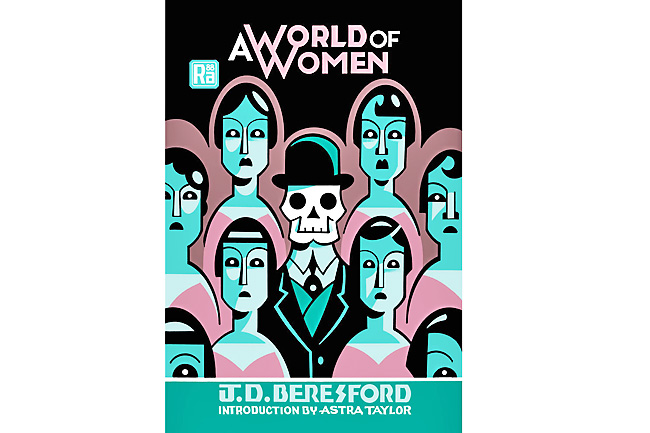Michael Dirda
THE WASHINGTON POST – Back in the late 19th and early 20th centuries, long before the availability of the atomic bomb, writers imagined various ways to wipe out humanity.
The villain of Guy Boothby’s Pharos the Egyptian (1899) unleashed a deadly epidemic, MP Shiel smothered us with The Purple Cloud (1901), James Elroy Flecker’s The Last Generation (1908) imagined the end of procreation, Jack London depicted the ravages of The Scarlet Plague (1912) and JJ Connington’s Nordenholt’s Million (1923) began with the death of grass.
As I can vouch, all of the above are apocalyptically entertaining, most of them employing widescreen devastation to clear the Earth so that, following a period of savagery, a saving remnant can lay the foundations for a new and better world.
Obviously, such books can often seem uncannily contemporary, and none more so than JD Beresford’s A World of Women (1913), the first novel in MIT Press’s newly launched science fiction reprint series, Radium Age. That phrase, from editor Joshua Glenn, assigns a label to “the best proto-science fiction novels and stories from 1900 to 1935”.
A sampler volume of short stories, Voices from the Radium Age, appeared earlier this year and included EM Forster’s scarily prescient The Machine Stops and William Hope Hodgson’s classic of somatic horror, The Voice in the Night.
Insightfully introduced by Astra Taylor, A World of Women opens with a complacent civilisation in collapse.
The cause? A deadly virus, albeit one that attacks only men. Its first mention already sounds eerily familiar: “Seems this new plague’s spreadin’ in China.”

Scientists postulate that the bacillus originated in some lower animal and jumped to humans. It’s hard to be sure, though, because front-line researchers – all male – quickly succumb to the disease.
Before long, the lethal sickness appears in czarist Russia, which quickly imposes a news blackout, then in Germany, which institutes quarantine. Naturally, Londoners blithely reassure themselves that “we’ll never get it in England”, even while the country’s elected officials politicise the virus as a ploy to undermine upcoming legislation.
A widely reported speech by Mr Brampton – soon to become Prime Minister – “poured contempt upon the fear of the plague, which he characterised throughout as the ‘Russian epidemic’, and ended with the advice to keep a cool head, to preserve the British spirit of sturdy resistance instead of shutting our doors and bringing the country to commercial ruin.
‘Are we all cravens,’ he concluded, ‘scurrying like rabbits to our burrows at the first hint of alarm?’ “
Needless to say, within a few weeks, Mr Brampton is dead, along with nearly every other man in England, and yet A World of Women is just beginning.
The book’s middle section, titled ‘The March of the Goslings’ zeroes in on Mr and Mrs Gosling and their two grown daughters, Blanche and Millie, as the family struggles to find enough to eat.
Eventually abandoning a pillaged London for the countryside, the three Gosling women – without Dad – trudge through derelict villages; confront female scavengers and survivalists; encounter a vigorous young butcher, immune to the disease, who has set himself up as a deity to a troupe of bacchantes; and, finally, discover a hard-working, socialistic community of female farmers.
About what happens in the novel’s last section, ‘Womankind in the Making’, I’ll only say that it closes on this subgenre’s typically hopeful note. Like Charlotte Perkins Gilman in her slightly later and even more radical Herland (1915), Beresford envisions a new society, based on communitarian principles, without the trammels of religion, class and female subservience to men.
Altogether, even a century after its first appearance, A World of Women remains highly readable and still sadly pertinent, as well as artistically surprising: Without warning, major characters can softly and suddenly vanish.
But who was John Davys Beresford (1873-1947)? In brief, he was one of the earliest, and best, disciples of HG Wells, about whom he wrote the first critical monograph. His own most-celebrated book, The Hampdenshire Wonder (1911), recounts the early years of an apparent “superman”.
From the moment Victor Stott is born, he disconcerts those around him. As a baby, he is thought to be dead, then suddenly opens his eyes. The doctor shivers, “for the eyes that stared into his own seemed to be heavy with a brooding intelligence.”
While still in short pants, “the Wonder” – as Victor is called – reads the dictionary, then the entire 11th edition of the Encyclopaedia Britannica, absorbing each column at a glance. After finishing its last page, he is heard to murmur: “So elementary… inchoate… a disjunctive… patchwork.” By age 7, Victor has mastered the contents of all the books in a local landowner’s vast private library.
Nonetheless, the little boy hardly speaks. Once, he does ask whether there are others of his kind (and is told there aren’t). And only rarely does he hint at the almost alien magnitude of his intelligence: “When he looked one in the face with intention, and suddenly allowed one to realise… all the dominating power of his brain, one shrank into insignificance.”
As the sympathetic narrator confesses: “I should have gone away if I had been free, but Victor Stott had a use for me, and I was powerless to disobey him. I feared him, but he controlled me at his will.”
Viewed metaphorically, The Hampdenshire Wonder illustrates both the loneliness and estrangement often felt by children with special needs and society’s reflexive fear of anyone who is “different”.
Still, however you interpret Beresford’s touching short novel, it remains, like its protagonist, a wonder – as does the more panoramic and comparably relevant A World of Women.






